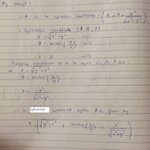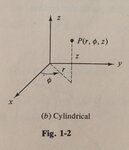dzafar
Member level 4
Hello there,
I was solving problem 1.14 in Schaum's Outlines Electromagnetics (2nd Edition).
The problem states to convert a vector A from Cartesian to Cylindrical coordinates. I am attaching the problem and my attempt towards it. The last image shows how the book solved it. My solution is way off and I can't seem to grasp the one in the book. Please let me know what I am doing wrong and also what the book is doing in the section I circled red.
Question:

My Attempt:

Book Solution:

Reference image:

Thanks for the help
I was solving problem 1.14 in Schaum's Outlines Electromagnetics (2nd Edition).
The problem states to convert a vector A from Cartesian to Cylindrical coordinates. I am attaching the problem and my attempt towards it. The last image shows how the book solved it. My solution is way off and I can't seem to grasp the one in the book. Please let me know what I am doing wrong and also what the book is doing in the section I circled red.
Question:
My Attempt:

Book Solution:

Reference image:

Thanks for the help
Last edited: